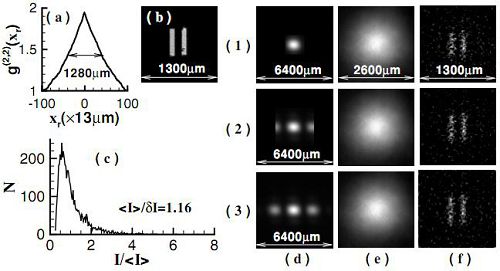Far-field high-resolution imaging is always an important topic in imaging science. In practical applications,the imaging resolution is mainly restricted by the system’s Rayleigh limit and detection signal-to-noise ratio(SNR).Ghost imaging (GI) is a method to nonlocally image an object with a single-pixel detector. However, the speckle’s transverse size at the object plane limits the system’s imaging resolution for conventional GI linear reconstruction algorithm.Recently, the image’s sparsity has been taken as a quite general assumption, a compressive sensing (CS) technique enables the reconstruction of an N-pixel image from much fewer than N global random measurements. Therefore, when CS is applied to the image reconstruction of GI, high-resolution far-field ghost imaging via sparsity constraint (GISC) is possible with the use of random measurement below Nyquist limit.

Figure Experimental reconstruction of a double-slit in different receiving areas. (a). The cross-section curve of normalized second-order correlation distribution; (b). the object; (c).the probability distribution of the intensity values measured by the bucket detector Dt relative to the statistical mean; (d). the object’s Fourier-transform diffraction patterns received by the test detector Dt; (e). GI reconstruction results; (f) GISC reconstruction results.
Professor Gong Wenlin and Han Shensheng from Key Laboratory for Quantum Optics and Center for Cold Atom Physics, Shanghai Institute of Optics and Fine Mechanics,Chinese Academy of Sciences, have experimentally demonstrated the high-resolution ability of GISC, by comparing the reconstruction results of GI and GISC techniques.
By combining the sparsity constraint of imaging object with ghost imaging method, they demonstrate experimentally that ghost imaging via sparsity constraint (GISC) can dramatically enhance the imaging resolution even using the random measurements far below the Nyquist limit. The image reconstruction algorithm of GISC is based on compressive sensing. Factors affecting the reconstruction quality of high-resolution GISC, such as the receiving system’s numerical aperture and the object’s sparse representation basis, are also investigated experimentally. This high-resolution imaging technique will have great applications in the microscopy and remote-sensing areas.
This study entitled” High-resolution far-field ghost imaging via sparsity constraint” was published onScientific Reports on March 19,2015.
The work was supported by the Hi-Tech Research and Development Program of China under Grant Project.

